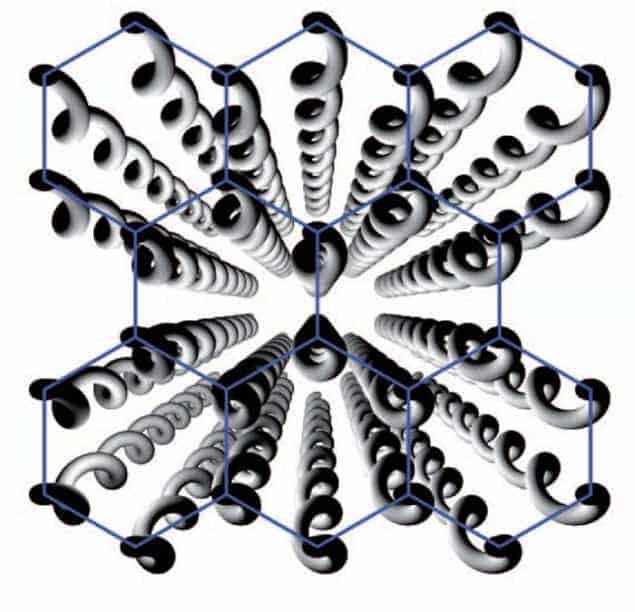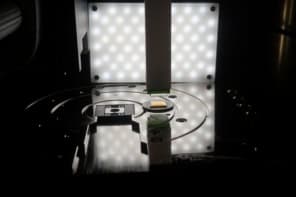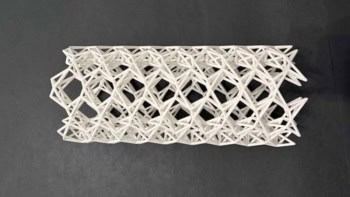
An optical analogue of a topological insulator has been created by physicists based in Israel and Germany. Consisting of an array of helical waveguides, light cannot propagate between waveguides in the bulk of the array but it can move unhindered along its surfaces – even when the light encounters significant surface defects. According to the team, these properties could allow the material to be used to simulate quantum phenomena or be used in photonic circuits.
Since they were first predicted in 2005 and subsequently identified in the lab, topological insulators have been a hot topic in condensed-matter physics. Electrical insulators in the bulk, these materials have surface states that conduct electrons extremely well. The robust nature of the surface conduction is a result of the topology of the system. The energy difference between the surface states and the bulk states is so large that an electron moving along the surface cannot scatter into the bulk.
Maintaining momentum
Even more importantly, a surface electron with a certain momentum is unable to scatter into a state with opposite momentum because doing so would involve flipping its spin – which it is forbidden from doing in ordinary materials. So the electron has no choice but to keep moving in the same direction. As a result, topological insulators show great promise for applications such a quantum computing, where scattering from defects will destroy quantum information carried by electrons.
Now a team – including Mikael Rechtsman, Yonatan Plotnik and Mordechai Segev of Technion and Julia Zeuner and Alexander Szameit of the Friedrich-Schiller University – has created an optical material that behaves much like a topological insulator. The researchers came up with the idea in 2011 when they read a theory paper that argued that a topological insulator could be created in a material by subjecting it to time-varying electromagnetic fields. They realized that the 2D Schrödinger equation of such a material is identical to the equation that describes the 3D propagation of light through an array of light guides – if the direction along the waveguides is treated as time rather than the z component of space.
Leaking light
If the waveguides are simply straight cylinders, light can leak from one waveguide to the next, which makes the array analogous to an electrical conductor in the x–y plane – indeed, the array is a honeycomb and its properties are similar to the electrical properties of graphene. But to simulate the time-varying fields, the waveguides would need to be helical as this opens up a gap in the x–y conduction band and stops light from moving between waveguides – creating a bulk insulator. However, as the surface propagation states endure, light would be free to propagate in the x–y direction on the surface.
To test the idea in the lab, the team took a piece of fused silica and used a femtosecond-laser-writing method – which modifies the local refractive index – to create the array of helical waveguides. The nearest-neighbour spacing between waveguides is 15 μm and the structure is 10 cm long. The researchers then fired a beam of light at an edge of the hexagonal face of the array and found, as expected, that the light propagated in the x–y direction on the surface of the structure – but not in the bulk. Furthermore, when the light reaches an edge of the array, it was found to propagate easily around the corner and keep going along the adjacent face – an example of how robust the surface propagation is.
To further test how persistent the surface propagation is, the team created arrays that are missing waveguides at the surface. Again, the researchers found that the light moved seamlessly through such defects, just as expected of a topological insulator.
Sub-wavelength materials
The team told physicsworld.com that such photonic topological insulations could find use in silicon photonics – circuits that use pulses of light to transmit information rather than electronic signals. A key challenge in creating tiny photonic circuits is preventing light from reflecting or leaking into places where it should not be – which can cause crosstalk between circuits. Ideally, this could be done using topological insulators that confine light to regions smaller than the wavelength of the light itself.
The physicists also believe that the materials could be useful as photonic simulators of quantum effects. These could be used, for example, to gain a better understanding of electrons in real materials. Finally, the group points out that those trying to build quantum computers that use photons as qubits could be interested in developing photonic topological insulators, because scatter-free propagation may aid in the development of a robust quantum computer.
The work is described in Nature.



